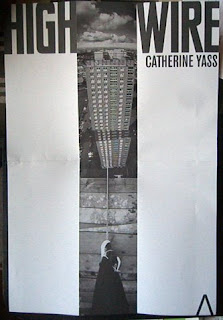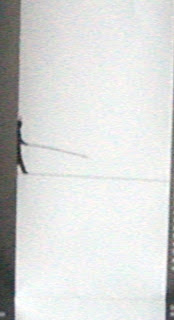 Paralysed by "business" overload, I escaped and went with a friend to see an Artangel installation, and hear a talk by the artist. Catherine Yass's High Wire is four films projected on the walls of a big room (the German Gymnasium), one of an aerial view of a housing estate in North Glasgow (Red Road) and the other three of a man walking a tightrope between two of the buildings - two shots from below and the other taken by the camera on his head. It was unexpected, and I get quite queasy even thinking about it. (I have no desire to see the film Man on Wire!)
Paralysed by "business" overload, I escaped and went with a friend to see an Artangel installation, and hear a talk by the artist. Catherine Yass's High Wire is four films projected on the walls of a big room (the German Gymnasium), one of an aerial view of a housing estate in North Glasgow (Red Road) and the other three of a man walking a tightrope between two of the buildings - two shots from below and the other taken by the camera on his head. It was unexpected, and I get quite queasy even thinking about it. (I have no desire to see the film Man on Wire!)
The talk was in interview format and well attended. The catalogue has an essay on the history and philosophy of highwire walking by Steven Connor, who is giving a talk on Weds 22 October - he's "a writer and broadcaster and Professor of Modern Literature and Theory at Birkbeck College, London. He has published important studies on ventriloquism and the history of sound and is working on a new book concerning the poetics of the air."
In a side room are three lightboxes of views of the housing estate, in black-white negative but with a blueish sky, with the tightrope added by scratching into the negatives. It shows as a bright, ragged line among the bleached detail of the photos. Catherine Yass mentioned the sense of defilement of scratching up photographic negatives.
As my friend said, there wasn't anything in the talk that we couldn't have figured out for ourselves - but for me, hearing about the ideas embodied in the work brought them to the surface. I wouldn't have been able to juxtapose the social-utopia ideas of the changing nature of housing estates, for instance (tower blocks will be pulled down when the last residents move out - lowrises are being built all around).  It's there in the leaflet, which I've just now read: the Red Road scheme "when built in the 1960s was the highest social housing in Europe, a triumph of the city planners' dreams to rebuild the city. Into the void between the planners' concrete dreams, another kind of dreamer, the French high-wire artist Didier Pasquette, steps out, at first gracefully, then hesitantly, and then he stops..."
It's there in the leaflet, which I've just now read: the Red Road scheme "when built in the 1960s was the highest social housing in Europe, a triumph of the city planners' dreams to rebuild the city. Into the void between the planners' concrete dreams, another kind of dreamer, the French high-wire artist Didier Pasquette, steps out, at first gracefully, then hesitantly, and then he stops..."
 It's there in the leaflet, which I've just now read: the Red Road scheme "when built in the 1960s was the highest social housing in Europe, a triumph of the city planners' dreams to rebuild the city. Into the void between the planners' concrete dreams, another kind of dreamer, the French high-wire artist Didier Pasquette, steps out, at first gracefully, then hesitantly, and then he stops..."
It's there in the leaflet, which I've just now read: the Red Road scheme "when built in the 1960s was the highest social housing in Europe, a triumph of the city planners' dreams to rebuild the city. Into the void between the planners' concrete dreams, another kind of dreamer, the French high-wire artist Didier Pasquette, steps out, at first gracefully, then hesitantly, and then he stops..."
He stopped because the wind, though slight, had set up a vibration in the wire - and he had to walk backwards - "c'est impossible" he shouted - you don't hear that on the film, just the noise of the air. Lisa and I happened to be watching the film just at that point, and yes the stopping was a bit puzzling. The explanation isn't in the leaflet. Interesting to speculate on the various possible outcomes of a project like this, and how that would affect its subsequent presentation.
Leaflet again: "HIGH WIRE" is the ultimate expression of [Yass's] interest in the vertiginous view. The new work juxtaposes the containment of the concrete blocks and the modernist idealism of streets reaching into the sky with the self-contained mental space of the high wire artist and the freedom of walking in the air." Hmm, I'd disagree with that last bit - can it be freedom if you're balancing on a thin wire, that had to be put there? I see it more as danger, risk - ok maybe that's a kind of freedom?

The catalogue has lovely endpapers - photos of the long stretch of Red Road in 1925, one looking toward the city, the other looking away. A man sits on the wall to connect the two. Among the essays is a stretch of side-on photos of the walker against a background of clouds, with the occasional bird passing by.
1 comment:
This makes me think of Philippe Petit's daring and wonderful walk between the two World Trade Center towers in 1974. Magical and insane!
http://www.manonwire.com/
Post a Comment